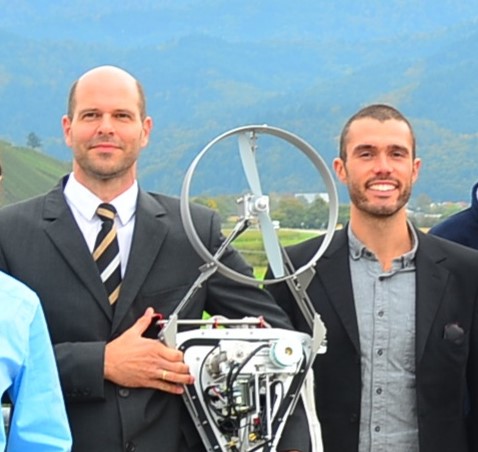What if we could harness that power with a kite? This is exactly what Wubbo Ockels thought when he patented airborne wind energy almost twenty years ago. Researchers at TU Delft are testing kite power and will sell their first system in 2018.
Roland Schmehl explains how kite power works. (Photos: TU Delft TV and Kitepower)
The idea is to have a kite flying up to 600 metres altitude in the sky and to harvest the strong wind up there. The wing of the kite is connected to a ground station and it reels into and out of the station. As it reels in, it uses a little bit of energy to get back to earth, but during reel-out, the 40m2 kite generates 32kW of power. In the video, Roland Schmehl, co-founder of the start-up, explains how this works.
Schmehl gives three reasons why kite power is better than wind turbines.

“At high altitudes there is a phenomenon called the jet stream. This jet stream can have velocities up to 250 km per hour and is steadier than the wind that is closer to the earth. There is an incredible energy up there. Wind turbines are closer to the earth and the wind speed here is generally lower and fluctuates more over time. By going higher, we have a new resource.” The team is using a kite that goes up to 600 metres.

“One of the prime arguments to use kites to harness the power of the wind, is that they need less material. If you compare the kite power system to the wind turbines, we only use a fraction of the material. Basically, we replace the concrete and metal structures of the wind turbines by intelligent systems, integrated services, computers, very low material use, tensile structures and a membrane. Less material makes lower costs, so we can harvest wind at much lower costs than wind turbines.”

People who live close to wind turbines often resist them. They think wind turbines are ugly, noisy, and have an irritating shadow. Kite power solves these problems. “It has a very low visual impact. The kite is hardly visible and the wing flies all the way up in the sky. Also, the acoustic impact is a lot lower than that of a wind turbine.”
There are a lot of benefits of kite power over wind turbines, but Schmehl doesn’t think it means the end of wind turbines. “Windturbines, an established technology, and airborne wind energy systems will be used together to accelerate the transition to a fully renewable energy economy. We will need many more years to advance these systems from their current state to large-scale kite parks that operate with a high reliability. In these years we will need conventional wind turbines and other renewables to cover the base load for our energy economy.”

Kite power sounds like the best option of harnessing wind energy. Why are we not using it right now? “We are experiencing a lot of technical and non-technical challenges. For example, we are going into airspace that is also used by aircraft and unmanned aerial vehicles, like drones. And we have a lot of technical issues, like reliability and automation. We are currently testing the kite in Valkenburg twice a week. We can now fly with a battery for three hours. We want to increase the flying time to 24 hours with, yes, a wind turbine! But a small one, with a diameter of 30 centimetres.”
Want to know more about the project? Read our article about the 100kW generator or the earlier interview with Roland Schmehl on the Airborne Wind Energy Conference (AWEC) 2015.
TU Delft TV / TU Delft TV is a collaboration between Delta and the Science Centre. The crew consists of TU Delft students.


![[VIDEO] Three reasons why Kite Power is better than wind turbines](https://delta.tudelft.nl/wp-content/uploads/2023/12/kitepowervideo1-scaled.jpg)
Comments are closed.